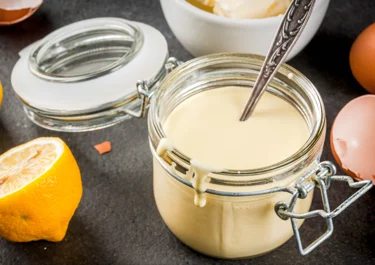
Hollandaise Sauce

Instructions
Ingredients
|
Lemon juice
|
1½ tbsp |
|---|---|
|
Water
|
1½ tbsp |
|
Egg yolks
|
2 |
|
Salt
|
1 pinch |
|
Ground cayenne pepper
|
1 pinch |
| 250 g |
Tips
Below, we list a few neat tips and tricks to help you perfect the art of cooking hollandaise sauce.
Do not panic if your sauce becomes too thin or separates. You can often fix it by whisking in a tablespoon of warm water or lemon juice over low heat. A different option is to add another egg yolk to the sauce while whisking continually until it emulsifies and thickens again. The best weapon is patience, so stick with it until the sauce reaches your desired consistency.
Use a blender for a quicker and easier way of making hollandaise sauce. Mix egg yolks, lemon juice, water, salt, and cayenne pepper in the blender. With the blender running at low speed, pour the melted butter in slowly. Using a blender can result in a slightly different texture, but the sauce is still tasty.
For the best results, hollandaise sauce should ideally be made and enjoyed on the same day. But if you want to store it, transfer it to an airtight container after cooling and then refrigerate it. If stored properly, it can be kept for 2–3 days. We recommend serving leftover Hollandaise cold as a dressing or cold sauce because the risk of splitting is very high even with a gentle reheat.
Make a quick and easy hollandaise sauce
Hollandaise sauce has long had the reputation of being difficult to make, but our recipe simplifies the process. With few ingredients, you can whip together a delicious sauce in no time. It is the perfect condiment to impress your guests.
For similar recipes to dazzle friends and family, try our crispy schnitzel, exquisite white asparagus, or boiled new potatoes. All these tasty dishes can easily be served with our velvety-smooth hollandaise sauce.
Rich, creamy texture with a subtle tanginess
The hollandaise sauce is famous for its luxurious texture and nuanced flavour. Allow the richness of the butter and egg yolks to impart the famous velvety smoothness to the sauce. The complexity comes from the combination of lemon juice and water. They balance the richness and inject the slightest touch of tanginess. Each taste will be a beautiful blend of buttery richness and zesty tang, allowing you to experience exactly why the hollandaise sauce has been popular for hundreds of years.
A classic sauce perfect for breakfast and brunch
One reason hollandaise sauce is so popular is its versatility. The classic sauce has been cherished for its ability to add a decadent touch to many dishes. Whatever the time of day, the hollandaise sauce is the perfect condiment if you want to inject a little luxury into your kitchen. Imagine a plate of beautifully poached eggs, savoury bacon, and crisp English muffin. What is missing? A stunning, silky-smooth river of sauce to bind the eggs Benedict together. The use of the hollandaise extends beyond breakfast and brunch options, as its indulgent flavour elevates everything from steamed asparagus, broccoli, and artichokes to delicate white fish like salmon and trout.
Experiment with the ingredients
While our recipe for hollandaise sauce excels in flavour and texture, feel free to get creative and experiment with it. There is plenty of room to personalise it to suit your needs.
For those who enjoy citrus but want to experiment with flavours, an orange hollandaise sauce may be perfect. The switch is simple: use orange juice instead of lemon juice. The result will be slightly sweeter, with mild fruity notes – but it maintains its creamy texture.
You can also introduce fresh herbs like tarragon, chives, or dill. They will all provide a welcome freshness that complements the rich and creamy notes of the sauce. More specifically, dill brings an herbaceous and citrusy flavour, while chives add mild onion notes. We recommend adding the herbs to the warm butter before further incorporating them into the sauce.
A simple variation on the classic is to find a good mustard and add it to the blend. Dijon or whole-grain mustard are fine choices that can add complexity to the taste. Mustard offers a mix of tanginess and savoury notes that fit neatly with the rich hollandaise sauce.











